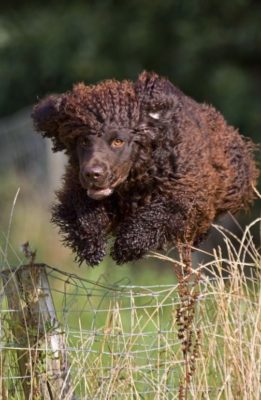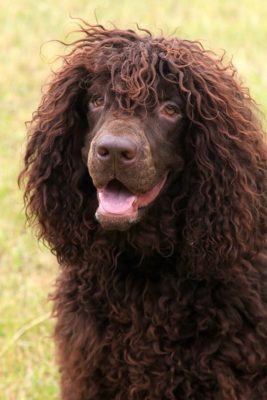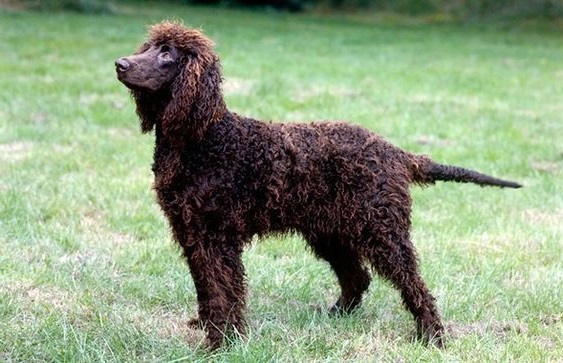Irish Water Spaniel
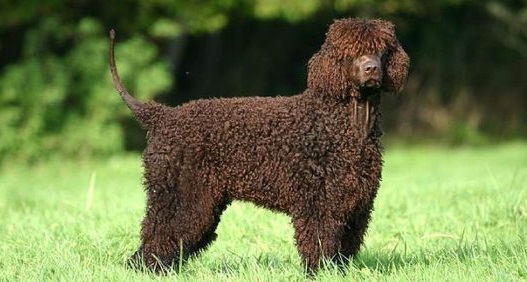
The Irish Water Spaniel is great for people who lead an active lifestyle. After all, she loves to run, jump and play with toys. He loves to go out into nature and is hardy to all weather conditions. It is worth considering its primary purpose and regularly allowing the spaniel to swim in a lake, river, or pool.
Table of Contents
Breed Information
| Another Name | Whiptail, Shannon Spaniel, Rat Tail Spaniel, Bog Dog |
| Origin | Ireland |
| Height | Males 53-59 cm Females 51-56 cm |
| Weight | Males 25-31 kg Females 20-26 kg |
| Fur | Long |
| Color | Brown |
| Lifespan | 12-13 years |
| FCI Classification | Retrievers – Flushing Dogs – Water Dogs |
| Group | Dogs for kids |
| Price | $700-1300 |
Breed Photos
Origin History
The breed’s origin is so old that it is now unknown exactly the basic breed from which the Irish Water Spaniel was bred. It is believed that there was a mixture of several breeds, and Irish scientist, founder of the breed Justin McCarthy, unfortunately, did not leave any records.
These dogs were once called Shannon Spaniels because the place of origin was in the south of Ireland, near the Shannon River. In the beginning, the dogs were used for hunting waterfowl wildlife. The first standard for the breed was made in the 1830s, with official recognition in 1862. The breed is officially standardized and has many favorites around the world. Cynologists believe that the Irish Water Spaniel has dogs such as the Poodle, the Barbet, the English Water Spaniel, and the Portuguese Water Dog in its blood.
Appearance
The Irish Water Spaniel is the tallest and most oversized of all spaniels. The height of males can reach 59 cm, bitches – 56 cm. The approximate weight is 30 kg. The dog has a strong, muscular torso, harmonious physique. The head is large, broad. The muzzle has a slightly elongated form, square outlines. The eyes are of medium size, most often brown. The nose lobe is dark brown. The ears are low set and have a hanging, long shape. The neck is stout and high up. The tail is hairless, thick, kept straight. The shape of the body is proportional even despite its large size.
The coat of the Irish Water Spaniel is long, curly, covering the dog’s body tightly. There is no fur on the muzzle. The color comes in any brown with a pronounced purple tint. On the head and chest, the coat is slightly longer than on the body. On the head is formed a “hat” of hair, hanging on the forehead.
Character
The Irish Water Spaniel is great for people who lead an active lifestyle. After all, she loves to run, jump and play with toys. He loves to go out into nature and is hardy to all weather conditions.
It is worth considering its primary purpose and regularly allowing the spaniel to swim in a lake, river, or pool. They are excellent swimmers, and this promotes good form.
Representatives of this breed can be good friends, keeping them company during any fun. They are good friends with children, even the smallest.
These dogs are not typical to show aggression or anger, so they can easily live in the same house with other animals. The Irish Water Spaniel is very active, cheerful, and kind.
Of the disadvantages of the breed is that they are not suitable to guard the house. After all, they are communicative and treat everyone well.
Care
It is recommended to keep the dog in an urban home. They are not suitable for apartment life. After all, they are active and spend a lot of time doing physical activities. They should have access to water, given their love of swimming.
They are athletic and need daily exercise. Taking care of them is simple – during shedding, the hair does not fall out and does not cling to the furniture but stays in the coat. Therefore, it should be regularly combed out with a brush.
The ears’ condition should be closely monitored since they are floppy and can be prone to disease. Once a week, it is advisable to brush the pet’s teeth and check its eyes. Bathing often is not recommended; it all depends on contamination.
You can go to the groomer several times a year, but not often, as the coat allows the dog to swim without problems and not get wet. If you cut it a lot, it will lose its waterproofing abilities.
Training
The Irish Water Spaniel is brilliant and intelligent and constantly demonstrates its working qualities. They have an excellent memory and the ability to learn. Classes should be varied; it is important to remember that he will not perform commands if the spaniel becomes bored. You can combine training and games, so the dog will remember better and will be constantly involved in the process. You should not shout at your pet or put him under pressure – they don’t react well to rudeness or criticism and may become offended. It’s best to motivate your spaniel with praise, affection, and something tasty.
Common Diseases
As a representative of large dogs, the Irish Water Spaniel is prone to these diseases:
- hip dysplasia;
- cataract;
- hypothyroidism;
- distichiasis;
- epilepsy.
Nutrition
Nutrition should be complete and balanced. It can be either natural food or food. If you choose the second option, the food must be of high quality and specially designed for mobile dogs.
Natural food should include foods that are high in calcium. An adult dog should be fed twice a day.
 Beagle-Harrier
Beagle-Harrier Thai Ridgeback
Thai Ridgeback Small Bernese Hound
Small Bernese Hound Sabueso Español
Sabueso Español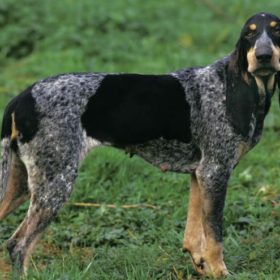 Petit Gascon Saintongeois
Petit Gascon Saintongeois Istrian Coarse-haired Hound
Istrian Coarse-haired Hound